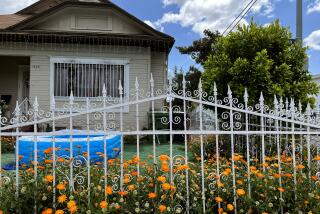Op-Ed: L.A. has a growing mansionization problem
My neighborhood is called either Fairfax Village or Mid-City West or Melrose or maybe all three. It is just north of the Grove and Park LaBrea, just south of West Hollywood. Since I work from home I often take walks nearby to unwind, and they’re usually pleasant, though lately I’ve had to take stock of new construction, new homes coming to market, a new shape and character of the place I live.
Not quite half a block north, I come to the first of several two-story fortresses of solitude, all blocky and bland, with minimal plantings, maximal space, rising high above the surrounding cottages. We call them McMansions, but to me that designation brings to mind something far friendlier, if equally cookie cutter. These structures (I have trouble conceiving of them as homes) are drab, impersonal follies, as ugly as they are obtrusive.
Earlier this month, the city planning commission released a report on so-called mansionization. It found that from 2005 to 2015, 57,224,810 square feet of either new additions or new construction had been developed in single-family zones throughout the city. Recently, the commission took steps to mitigate the problem. It voted to eliminate various loopholes, including one that grants a 20% square footage bonus for building “green.” But the City Council must review and sanction these changes before they become law, and plenty of loopholes still exist — attached garages, for example, do not count against total built space if they’re located at the back of the property.
Unfortunately, very little about the proposed adjustments will do anything to curb the underlying realities that incentivize such unlovely building choices. Much of Los Angeles is still zoned for single-family house construction, so developers can’t maximize the space available — and their profits — with multiple units. Instead, developers drive up the asking price by piling up the square footage.
It’s not just the aesthetics that bother me. All those additional square feet add up to an enormous waste of space.
Community groups rail against large apartment buildings going up in Hollywood and downtown, but it’s the mansions that are out of step with reality.
In “Life at Home in the 21st Century,” UCLA researchers tracked 32 middle-class Angelenos, trying to measure and analyze how we live today. One family in particular they followed intimately, tracking how they moved around the house during the mornings, evenings, and weekends — when they were all home. The results were amazing: the family huddled around the kitchen and family room nearly all the time, leaving the living room, porch, and more than 50% of the rest of the first floor communal spaces almost entirely empty. The habit of gathering around the kitchen to eat, or huddling in front of the TV to watch, hasn’t changed much since the 1950s, but the average home size has — from 983 square feet in 1950 to more than 2,660 square feet today. Meanwhile, the average family size has shrunk and so has the average number of people living under one roof, from 3.3 in 1960 to 2.54 today.
We’ve managed to build more space for fewer people in a city with arguably the worst housing crisis in America. Mansionization is the inverse of densification—less space for more people—which we desperately need to keep L.A. halfway affordable and environmentally sustainable in the long term. Community groups rail against the large apartment buildings going up in Hollywood and downtown, but it’s the mansions that are terribly out of step with the reality of this city.
After the July planning commission meeting on mansionization, I received an email from the L.A. Conservancy, where I’m a member. The email highlighted some of the people who had spoken out against the big structures, including one who asked that single-family homes be “built to scale” — which is exactly right, but also exactly wrong.
The scale of most new homes built in L.A. is far too large, and the scale of single family lots in L.A. is also far too large. The scale of the city as a whole has changed, and will continue to change. It’s time our conception of what’s important in a home and a neighborhood changed along with it. There are models worth replicating out there, some old and some new: the bungalow courts throughout Hollywood and Pasadena; the pre-war small lots and apartments we now treasure and the Conservancy lobbies to protect; the adaptive reuse of office buildings and motels, transformed into efficient apartments.
There are newer examples, too, such as Barbara Bestor’s Blackbirds, the 18 small lot town homes in Echo Park. These are pricey, and coveted, and sold quickly. The same people who are snapping up these homes could likely afford the fortresses in my neighborhood — which sit on the market for what seems like forever — but have realized there’s more to a house than square feet, and that the very idea of what a home in Los Angeles looks like needs to change to fit life in the 21st century.
Ryan Bradley is a freelance writer in Los Angeles.
Follow the Opinion section on Twitter @latimesopinion or Facebook
MORE FROM OPINION
In the overwhelmingly male world of American politics, Hillary Clinton’s milestone matters
Let’s name TSA lines after politicians
Outrage over Hinckley’s acquittal changed American law for the worse
More to Read
A cure for the common opinion
Get thought-provoking perspectives with our weekly newsletter.
You may occasionally receive promotional content from the Los Angeles Times.










